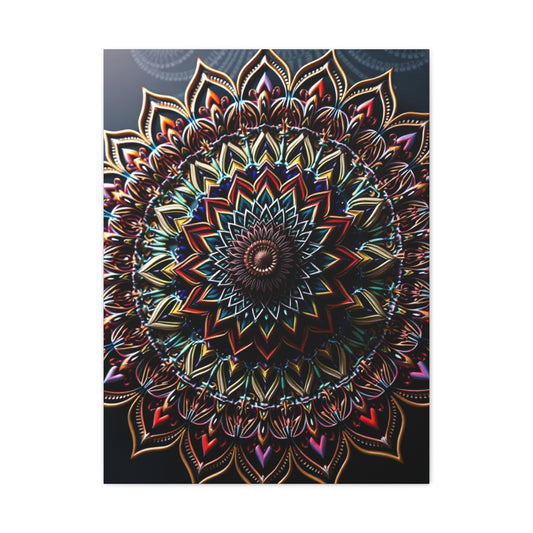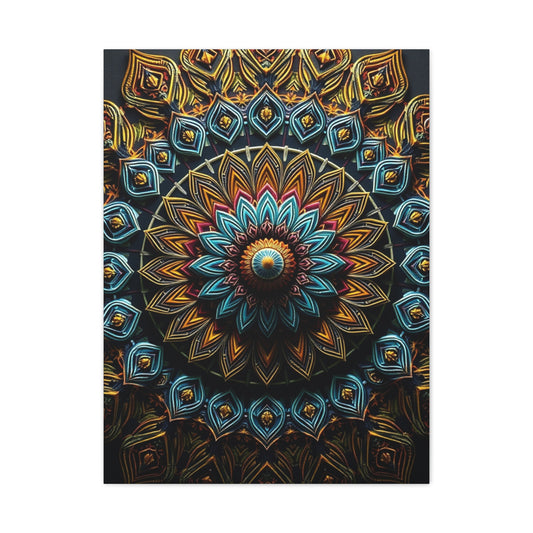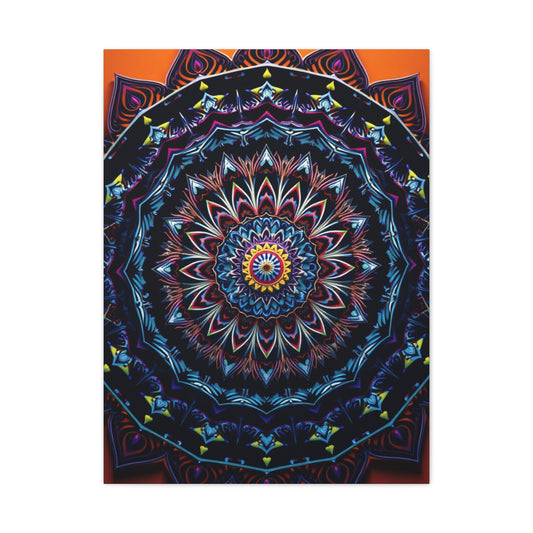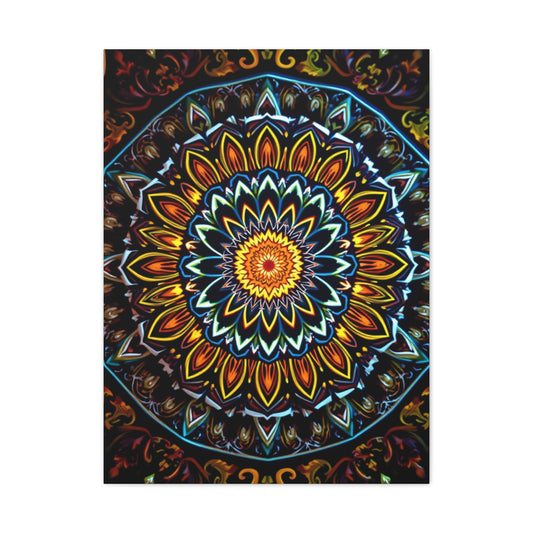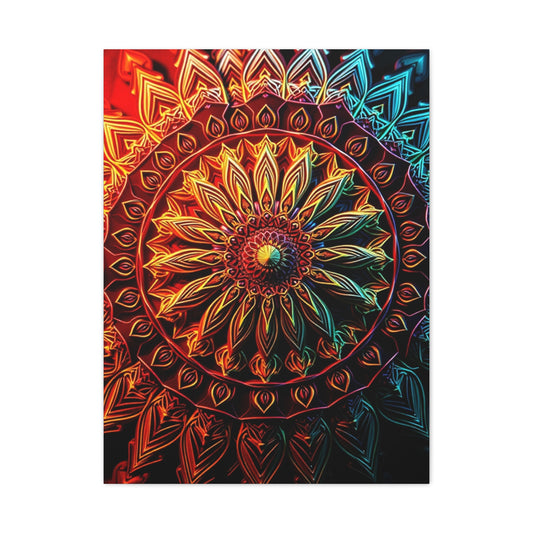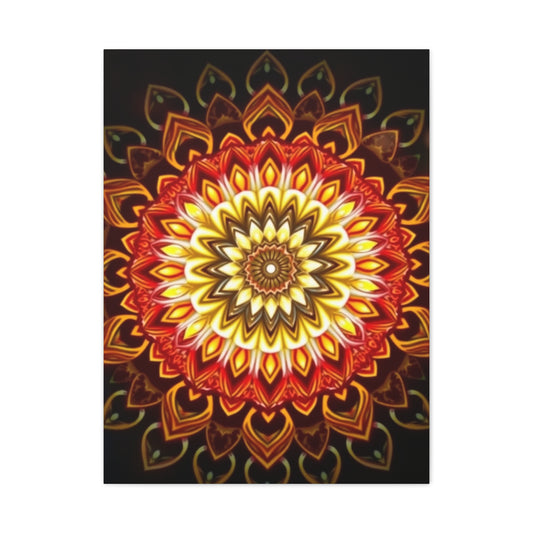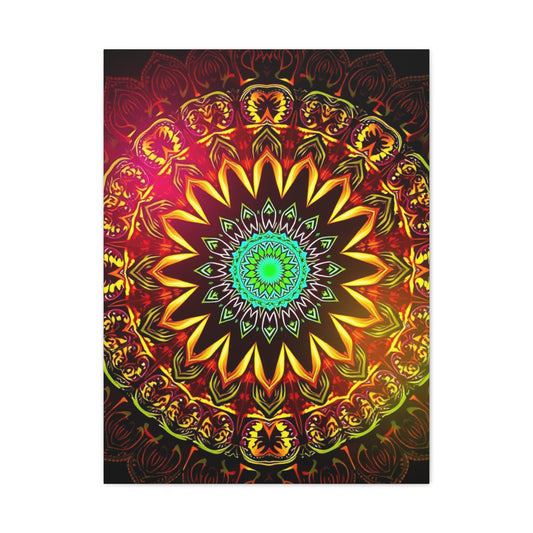From Tradition to Décor: The Evolution of Mandala Wall Art
Mandala art has enchanted human imagination for centuries, standing as a timeless embodiment of geometry, harmony, and spirituality. At its essence, a mandala is not just an arrangement of circles and lines but a symbolic map of the universe, representing balance, continuity, and interconnectedness. Its circular form embodies the eternal rhythm of life, from the cosmic order of galaxies to the intimate cycles of breath and thought within a person’s inner world.
The fascination with mandala art extends beyond religious practices, moving into modern psychology, meditation, therapy, and home décor. Its patterns are at once hypnotic and grounding, allowing individuals to encounter peace, focus, and an awareness of the infinite. This duality of artistic beauty and spiritual depth makes mandala art one of the most profound visual languages known to humanity.
As mandala wall art finds a place in contemporary interiors, its meaning has expanded to embrace not only spiritual significance but also aesthetic appeal. Whether displayed on a canvas, carved into architecture, or rendered with colored sand, mandalas evoke serenity, making them versatile creations that bridge ancient tradition with present-day creativity.
Historical Background
The roots of mandala art reach deep into ancient civilizations, where geometry was perceived as a sacred language. The earliest mandalas can be traced to India, where they formed a central part of Hindu rituals and later became indispensable to Buddhist traditions. The Sri Yantra, a well-known Hindu mandala, consists of interlocking triangles that represent cosmic creation and divine balance. This emblem was not only drawn but also meditated upon, embodying the aspirant’s spiritual path toward higher states of consciousness.
As Buddhism spread from India to Tibet, China, Japan, and beyond, mandalas journeyed with it, evolving into elaborate artistic and spiritual instruments. Tibetan monks perfected the creation of intricate sand mandalas, which took weeks to complete, only to be swept away in an intentional act of impermanence. This ritual destruction symbolized life’s fleeting nature, reminding practitioners that nothing material is permanent, and detachment is essential for enlightenment.
Outside of Asia, echoes of mandala-like patterns appeared in disparate cultures. The Native American medicine wheel symbolized the cycle of life, the balance of directions, and connection with natural elements. Gothic rose windows in European cathedrals mirrored the radial symmetry of mandalas, filling sacred spaces with light filtered through colorful geometric designs. Celtic knots, too, embraced endless interwoven circles, echoing themes of eternity and unity. Even in Mayan and Aboriginal art, circular patterns served as cosmic diagrams, linking humanity to the divine order of the universe.
Thus, the historical background of mandala art is not confined to one tradition but spans continents and civilizations, each interpreting the circle as a universal symbol of completeness and spiritual harmony.
Core Concepts and Foundations
At the heart of mandala art lies the idea of a sacred circle, a universal blueprint of existence. Every mandala begins from a central point, often described as the seed or origin. From this center, designs radiate outward in symmetrical patterns, signifying expansion, movement, and the unending cycles of life.
The foundations of mandala art are rooted in balance. Each quadrant or section of a mandala mirrors the others, reinforcing the principle of harmony between opposing forces—light and dark, inner and outer, finite and infinite. This equilibrium is not static but dynamic, reflecting how the universe itself is constantly in flux while maintaining balance within chaos.
Philosophically, mandalas embody the relationship between the microcosm and macrocosm. The smallest detail in a mandala is said to correspond to the larger universe, suggesting that human consciousness is a reflection of cosmic order. This principle resonates with both Hindu and Buddhist thought, where meditating upon a mandala becomes a journey from the external physical world into the innermost sanctum of the spirit.
In psychological contexts, particularly through the work of Carl Jung, mandalas represent the self. Jung described mandalas as archetypal images of wholeness, symbols that emerge from the subconscious during moments of transformation or healing. To him, drawing or contemplating a mandala was a way of achieving individuation—the integration of the conscious and unconscious mind. This profound interpretation has carried mandalas beyond temples into therapeutic practices, where they function as tools for emotional clarity and mental balance.
Types and Categories
Mandalas, though universally circular, manifest in diverse forms depending on their cultural or spiritual context. Each type carries its own meaning, intention, and application.
One of the most recognized types is the teaching mandala, which is a visual representation of philosophical or spiritual concepts. These are often used to illustrate lessons, showing the path from ignorance to enlightenment. They are intricate maps of wisdom, where each symbol or figure within the mandala holds a teaching of its own.
Another category is the healing mandala, intended to restore harmony and health. These mandalas are believed to channel energies that support mental clarity, physical recovery, and emotional well-being. They are often used in meditative practices to focus the mind on restoration and balance.
The sand mandala stands as one of the most spectacular expressions of this art form. Tibetan monks dedicate weeks to creating these detailed mandalas using colored sand. The painstaking process of arranging each grain is itself a meditative act, requiring patience, precision, and devotion. Upon completion, the mandala is dismantled, its sands scattered into rivers or winds, symbolizing impermanence and the return of matter to nature.
There are also architectural mandalas, visible in sacred spaces such as temples, cathedrals, and mosques. Domes, rose windows, and floor mosaics often reflect mandala patterns, embedding geometry into architecture to inspire awe and contemplation. These physical manifestations transform entire spaces into living mandalas, where worshippers feel enveloped by cosmic design.
In modern times, new categories of mandala art have emerged, such as decorative mandalas used in fashion, tattoos, and home décor. Mandala wall art, for instance, has become popular for its ability to bring a sense of tranquility and balance to interiors. While not always rooted in traditional symbolism, these designs still carry the aesthetic power of symmetry and harmony.
Practical Applications
The relevance of mandala art today extends far beyond its traditional spiritual role. Its versatility has allowed it to become a valuable tool in meditation, therapy, education, and even design.
In meditation, mandalas serve as visual anchors. By focusing on the central point and tracing outward patterns with the eyes, practitioners achieve heightened concentration and mental clarity. This practice quiets the restless mind and opens pathways to deeper states of mindfulness. The meditative act of coloring or drawing mandalas has similarly gained popularity, offering people a simple yet profound way to release stress and enter a state of flow.
Therapeutically, mandalas are used in art therapy sessions to help individuals explore emotions and recover from trauma. The repetitive act of creating symmetrical designs can calm anxiety, while the imagery itself often reveals subconscious thoughts. Many therapists employ mandala art exercises to support self-expression and healing, as they bypass verbal limitations and speak directly to the psyche.
In education, mandalas are incorporated as tools for teaching geometry, symmetry, and cultural history. Students not only learn mathematical patterns through mandalas but also encounter cross-cultural perspectives that expand their understanding of art and spirituality.
On a practical level, mandala wall art enhances interiors by cultivating a serene environment. The balanced forms create visual harmony, which can be especially beneficial in spaces intended for relaxation, such as meditation rooms, yoga studios, or bedrooms. Homeowners often use mandala tapestries, paintings, or decals to evoke tranquility and aesthetic charm in their living spaces.
Mandalas also thrive in personal adornment. Tattoos featuring mandala art symbolize strength, spiritual awakening, and wholeness. Fashion items adorned with mandala designs—whether scarves, jewelry, or bags—carry subtle connotations of balance and mindfulness.
Even digital spaces have adopted mandalas. Mobile apps for meditation, mindfulness, and creativity often feature mandala patterns for users to color or contemplate, blending ancient wisdom with modern technology.
Through these varied applications, mandala art has proven to be a timeless practice, one that adapts to shifting eras while retaining its essential meaning: the pursuit of wholeness, balance, and harmony.
Emerging Trends in Wall Art
Wall art has become more than ornamentation; it is now an intimate expression of individuality, cultural identity, and emotional resonance. The evolving landscape of interior design has transformed how art is perceived within homes and workplaces. No longer confined to canvases in galleries, wall art has emerged as an essential element in shaping mood, storytelling, and spatial atmosphere. Modern tastes reflect a fusion of tradition, innovation, sustainability, and personalization, and mandala art has found a unique place within this panorama.
One of the dominant trends in wall art is the return to handcrafted authenticity. People are increasingly drawn to works that reveal the human touch—brushstrokes, hand-carved textures, and organic imperfections. Mandala wall art exemplifies this movement, as each piece often bears evidence of deliberate craftsmanship, whether through intricate ink drawings, sand patterns, or wood carvings. The appeal lies in its ability to combine precision with warmth, offering both geometric clarity and soulful imperfection.
Another emerging trend is the rise of oversized wall art. Large murals or expansive prints create immersive experiences, transforming plain walls into visual sanctuaries. Mandalas, with their radial symmetry, adapt particularly well to this scale, enveloping viewers in concentric energy that promotes focus and tranquility. In meditation rooms or yoga studios, such pieces serve not only as décor but also as functional tools for mindfulness.
Sustainability has also reshaped the future of wall art. Artists are turning to eco-friendly materials—recycled wood, natural dyes, and ethically sourced fabrics. Mandala wall hangings created with organic cotton, handwoven textiles, or reclaimed metals embody both ecological responsibility and aesthetic refinement. In this way, mandala art contributes to conscious living, aligning design with environmental stewardship.
Customization is another noteworthy trend. Modern buyers often seek personalized art that reflects their inner journeys. Digital tools allow artists to design mandalas tailored to an individual’s preferences in color, symbolism, or theme. Some people commission mandala murals with personal motifs, weaving their life stories into the geometry. This personalized approach transforms art into a collaborative dialogue between creator and collector.
Digital integration has introduced new frontiers. Augmented reality and projection-based wall art allow shifting patterns to animate surfaces, creating dynamic mandalas that change with mood or music. These immersive experiences combine ancient symbols with futuristic technology, inviting audiences to step into living, breathing art forms.
Minimalism also influences current preferences. While some mandala wall art remains ornate, others are distilled into simple, monochromatic outlines that resonate with contemporary interiors. This pared-down approach reflects a desire for calm spaces free of clutter, where subtle mandalas serve as meditative focal points without overwhelming the room.
Global fusion is perhaps the most striking of all. Artists are blending motifs from diverse cultures—African tribal patterns, Japanese waves, or Middle Eastern mosaics—with mandala geometry to create hybrid designs. These cross-cultural dialogues reveal the universality of circular symmetry while celebrating distinct artistic heritages.
In sum, the emerging trends in wall art reveal a movement toward meaningful, mindful, and versatile design. Mandala art, with its timeless appeal and adaptability, continues to evolve, embodying harmony while embracing new technologies, sustainable practices, and global perspectives.
Techniques and Methods
The creation of mandala art is a discipline that demands patience, focus, and a refined understanding of both geometry and symbolism. Every design begins from a central point, a nucleus of energy from which the entire composition expands. Artists often describe this process as meditative, for each line and curve radiating outward reinforces the sense of balance and harmony that defines mandalas.
Traditional methods rely on sacred geometry. Circles, squares, triangles, and lotus petals are among the most common motifs, each chosen with intention. Compasses and rulers may be used to achieve precision, while freehand designs are often guided by an internal rhythm that prioritizes flow over exact measurement. In both cases, symmetry is critical, for it is symmetry that lends a mandala its sense of wholeness.
In Tibetan sand mandalas, the method is particularly meticulous. Colored sands are carefully placed grain by grain using tools called chakpur, which create vibrations that cause the sand to trickle evenly. This painstaking process can take weeks, and its completion is followed by dismantling, a reminder of impermanence and the cyclical nature of life.
In Hindu traditions, yantras—geometric mandalas with triangles, circles, and lotus forms—are drawn using rice flour, chalk, or colored powders. These are not merely artistic but functional, used as altars for meditation, prayer, and ritual. The Sri Yantra, with its interwoven triangles, is one of the most complex examples, believed to embody cosmic principles.
In contemporary practice, mandala art is created with pens, paints, or digital tools. Some artists employ dot painting, where thousands of small dots form intricate circular designs. Others explore mixed media, blending watercolor washes with inked symmetry to create depth and dimension. Digital platforms have also expanded possibilities, allowing artists to use software for precision and experimentation with color palettes.
Color plays a vital role in mandala creation. Each hue conveys specific moods or symbolic meanings. Blue often reflects tranquility and openness, red embodies vitality and passion, gold represents enlightenment, while green suggests growth and renewal. The thoughtful selection of colors transforms a mandala from a simple pattern into a symbolic landscape that resonates with the observer.
Mandala wall art, in particular, has become a favored expression of these techniques. Large-scale murals often feature hand-painted symmetry, while stenciled or digital prints bring crisp precision into modern interiors. Artists may also explore three-dimensional methods, carving mandalas into wood, metal, or stone to add tactile depth. Whether traditional or modern, the techniques all honor the essence of the mandala: unity expressed through repetition and symmetry.
Challenges and Common Mistakes
While the allure of mandala art is strong, its creation presents challenges that can be overlooked by beginners and even experienced practitioners. One of the most common difficulties lies in achieving symmetry. Even a minor imbalance in the lines or spacing can disrupt the overall harmony, leaving the mandala feeling uneven or distorted. For this reason, many artists must develop both technical precision and mental patience, recognizing that errors are part of the learning process.
Another frequent challenge is overcomplication. Enthusiasts often attempt highly intricate designs without first mastering simpler patterns, leading to confusion, frustration, and unfinished works. Mandala art thrives on gradual layering, where complexity emerges step by step rather than being forced all at once.
The misuse of color is another obstacle. Mandalas rely on a careful interplay of shades, yet beginners sometimes choose colors haphazardly, resulting in clashing tones that overwhelm rather than soothe. Understanding the symbolic resonance of colors as well as their visual harmony is essential to crafting balanced art.
A deeper mistake lies in treating mandala art purely as decoration without acknowledging its contemplative nature. While it is true that mandala wall art enhances interiors, historically, these forms were created as sacred diagrams. Ignoring this dimension risks stripping the mandala of its symbolic richness. This does not mean every modern creation must be religious, but an awareness of its heritage can enrich the artistic process.
In meditative practices, impatience often emerges as a stumbling block. The act of gazing at or coloring mandalas is meant to be slow, reflective, and immersive. Many people, however, rush through the process, missing the opportunity to quiet the mind. The true gift of mandala art lies in surrendering to its rhythm, allowing time itself to dissolve into the circular flow.
For digital artists, another challenge is sterility. Perfectly precise software-generated mandalas can sometimes lack the organic warmth of hand-drawn designs. The slight imperfections of human touch contribute to the vitality of traditional mandalas, and digital creators must find ways to balance precision with expressive individuality.
Recognizing these challenges and mistakes is not about discouragement but about cultivating awareness. Every flaw, whether a misplaced line or a rushed process, becomes part of the learning journey. In fact, many traditions view imperfections in mandala art not as failures but as reminders of human vulnerability and impermanence.
Trends and Future Outlook
Mandala art has entered a period of revival in the modern age, gaining popularity not only in spiritual circles but also in mainstream culture. Its hypnotic patterns appear in fashion, digital media, architecture, and interior design, showing that its symbolism continues to resonate in contemporary life.
One of the most noticeable trends is the rise of mandala wall art in homes and workplaces. As mindfulness and meditation gain traction, people increasingly seek environments that support calmness and balance. Mandala murals, decals, and framed prints offer more than decoration; they provide psychological anchoring points, creating sanctuaries within everyday spaces.
Digital technology has also expanded the reach of mandala art. Apps now allow users to create, color, and interact with mandalas on screens, blending ancient symbolism with modern convenience. Social media platforms have amplified this trend, where digital mandala artists share intricate designs to global audiences. Virtual reality may soon deepen this experience, enabling immersive environments where participants step inside mandala patterns for meditation and exploration.
Another emerging trend lies in therapeutic applications. Mandala coloring books have already gained immense popularity as tools for relaxation and stress relief. Looking ahead, mandala-based therapies may integrate with neuroscience, exploring how symmetrical patterns influence brain waves, reduce anxiety, and enhance focus. This intersection between ancient art and modern science suggests an exciting frontier.
Cultural fusion is also shaping the future of mandala art. While rooted in Hinduism and Buddhism, mandala patterns are now being adapted across diverse artistic traditions. Designers merge mandala geometry with African textiles, Native American motifs, or contemporary minimalism, creating hybrids that honor multiple lineages while expanding creative boundaries.
In sustainable design, mandalas are appearing in eco-friendly architecture, landscaping, and garden layouts. Circular designs not only carry aesthetic appeal but also align with ecological principles of balance and cycles. Green spaces shaped as living mandalas are becoming sanctuaries for meditation, wellness retreats, and communal gatherings.
The outlook for mandala art suggests continued growth in both spiritual and secular domains. As people seek harmony in an increasingly chaotic world, the mandala offers timeless guidance. Whether through digital innovations, therapeutic practices, or creative décor, the mandala’s future remains luminous, constantly adapting while retaining its symbolic essence.
Expert Insights
The voices of experts, both traditional and contemporary, shed light on the enduring relevance of mandala art. Tibetan lamas, Hindu priests, psychologists, and modern artists each approach mandalas from unique perspectives, yet their insights converge on the idea of wholeness.
Spiritual teachers emphasize the mandala as a map of consciousness. In Tibetan Buddhism, lamas explain that entering a mandala through meditation is akin to journeying toward the divine palace of deities. Each gate, quadrant, and symbol reflects a stage of spiritual evolution. Similarly, Hindu practitioners describe yantras as doorways into cosmic energy fields, instruments that align the human mind with universal forces.
Psychologists, inspired by Jung, affirm the therapeutic value of mandalas. Contemporary art therapists note that patients who engage in mandala drawing often experience catharsis, clarity, and improved emotional balance. Studies suggest that the structured yet open-ended nature of mandalas provides a safe container for inner exploration, enabling individuals to face unresolved feelings with calmness.
Modern artists view mandala art as a bridge between tradition and innovation. Some speak of the meditative discipline required to construct intricate designs, describing it as a form of visual prayer. Others explore experimental approaches, combining mandala geometry with abstract expressionism or digital animation. For these creators, mandalas represent not only sacred symbols but also endless possibilities for artistic exploration.
Interior designers and wellness experts highlight the impact of mandala wall art on psychological well-being. They observe that clients often feel more at peace in rooms adorned with symmetrical mandalas, reporting reduced stress and heightened focus. This practical wisdom aligns with the idea that geometry itself influences human perception, evoking calmness through order and rhythm.
Even scientists have begun to explore mandalas with renewed curiosity. Neuroscientists studying brain activity during mandala meditation have found correlations between focused visual engagement and states of deep relaxation. Such findings suggest that the ancient intuition behind mandala use may have neurological foundations, linking timeless art with measurable modern science.
The convergence of these insights reveals mandala art as a living tradition, one that transcends categories of religion, psychology, art, and science. It is not confined to any single era or culture but evolves continuously, offering humanity a versatile tool for self-discovery, spiritual connection, and aesthetic pleasure.
Step-by-Step Guides
For those who wish to engage directly with mandala art rather than merely admire it, practical step-by-step guides provide entry points into creation and application. Whether the goal is to produce a hand-drawn mandala, apply a mandala mural to a wall, or use a mandala for meditation, the process itself is as rewarding as the outcome.
Creating a Hand-Drawn Mandala
The process of drawing a mandala begins with preparing a quiet and intentional environment. Sit with a compass, pencil, eraser, and paper. Begin by marking a central point—the seed of your design. From there, draw a series of concentric circles using the compass, each circle serving as a guide for patterns.
Divide the circle into equal sections, usually by drawing straight lines through the center, creating quadrants or radial segments. These act as frameworks for symmetry. Within each section, add repeating motifs such as petals, triangles, or waves, ensuring that each shape mirrors its counterparts across the mandala. Continue layering outward, building complexity step by step.
Once the basic outline is complete, add detail. Dots, spirals, and lattice-like patterns can fill spaces, enriching the texture of the design. When satisfied, ink over the pencil lines with a fine pen for permanence. Finally, introduce color, choosing shades deliberately for their mood or symbolism. The finished mandala will be both a personal artwork and a reflection of meditative focus.
Designing a Mandala Wall Mural
Creating mandala wall art on a large scale requires planning and patience. Begin by selecting the wall space and preparing its surface—clean, smooth, and primed for paint. Using a projector or grid system, lightly sketch the central circle and extend radial lines outward. This ensures proportional accuracy even at a large scale.
Choose motifs that align with the purpose of the space. In a yoga studio, lotus petals and flowing curves may evoke serenity; in a modern living room, geometric simplicity may suit the décor. Begin painting from the center outward, maintaining balance as the design expands. Work in layers, allowing colors to dry before adding intricate details.
The process can take days, yet the result transforms the room into a sanctuary. A well-executed mandala mural becomes both a meditative tool and a statement of artistic dedication.
Using Mandalas for Meditation
To use a mandala as a meditative focus, begin by selecting a design that resonates with your intentions. Sit comfortably in front of the mandala, whether it is drawn on paper, displayed as wall art, or rendered digitally. Focus your gaze on the center, allowing your breath to synchronize with the symmetry of the design.
As your eyes trace outward from the center to the edges, imagine moving along a spiritual journey, from the material world toward inner stillness. If thoughts arise, return to the pattern, letting its rhythm guide your focus. This practice can be continued for ten minutes or longer, gradually deepening concentration and calmness.
Coloring Mandalas as Therapy
Coloring mandalas has become a popular form of art therapy, accessible to all ages. Begin with a printed or hand-drawn mandala outline. Select colors intuitively, allowing the process to unfold without overthinking. Fill each section patiently, noticing how colors interact and how your mood responds. The repetitive act of coloring induces a state of flow, easing stress and encouraging self-expression. The finished piece becomes a record of your inner state during the process, offering insight and healing.
Incorporating Mandalas in Daily Life
Beyond art-making, mandalas can be woven into daily life in subtle ways. Arrange objects in circular formations on a table to create a mandala-like altar. Use mandala tapestries as meditative backdrops. Practice mindful breathing while tracing a finger along a mandala design. These simple practices extend the mandala’s symbolism into everyday rituals, cultivating awareness and balance.
Trends and Future Outlook
The horizon of wall art is expanding in extraordinary ways, shaped by shifting lifestyles, technological breakthroughs, and evolving philosophies of space. Wall art is no longer an accessory but a central narrative within interior environments, echoing cultural diversity and individual consciousness. As the twenty-first century progresses, the role of mandala art within this spectrum is poised to become even more profound, reflecting both continuity with ancient traditions and adaptation to contemporary sensibilities.
One notable trend is the integration of digital technology. Virtual reality and augmented reality are redefining the way art interacts with its audience. Imagine a room where a mandala wall painting does not remain static but subtly shifts in color and rhythm as light changes or music plays. Such innovations create immersive atmospheres where walls become interactive canvases, blending artistry with multisensory engagement. These digital mandalas embody the dialogue between timeless symbolism and futuristic design.
Another dimension shaping the future is sustainability. As ecological awareness grows, so too does the desire for wall art crafted from renewable or recycled materials. Mandala designs carved into bamboo panels, woven into organic textiles, or painted with plant-based pigments offer not only visual delight but also ethical resonance. The sustainability trend is not merely aesthetic; it is a conscious decision that transforms walls into testaments of responsibility toward nature.
Global interconnectedness continues to enrich artistic trends. Cross-cultural dialogues bring motifs from different civilizations into harmony with mandala geometry. We now see fusions of Celtic knots interwoven with mandala petals, or Andean textile patterns merged with radial symmetry. This synthesis honors diversity while underscoring universal human attraction to cyclical and circular forms. The global character of wall art ensures that no single tradition dominates but rather contributes to a vibrant mosaic of shared creativity.
Minimalism and maximalism coexist as parallel currents shaping design philosophies. On one hand, there is an increasing demand for pared-down, monochromatic mandala outlines that offer tranquility and clarity within uncluttered interiors. On the other hand, there is a surge of interest in bold, intricate, and large-scale murals that engulf entire walls, celebrating intensity and detail. This duality reflects the broader human search for balance between silence and exuberance.
Personalization is also anticipated to play a larger role. With digital tools and accessible design platforms, individuals can co-create wall art that reflects their own journeys. Custom mandala murals designed to embody personal milestones, spiritual symbols, or color preferences turn homes into private sanctuaries. In this way, art becomes less of a commodity and more of an intimate companion, speaking directly to its owner’s essence.
The therapeutic role of wall art is another trend gaining momentum. With increasing attention to mental well-being, mandalas serve as more than visual décor. They act as meditative focal points, tools for stress reduction, and anchors of mindfulness. Future wellness spaces—clinics, spas, yoga centers, even corporate offices—are expected to integrate mandala wall pieces as functional instruments for psychological harmony. Such uses highlight the merging of art with science, creativity with healing.
Technology, sustainability, globalization, personalization, and wellness together mark the contours of what wall art will become. Mandala art, with its versatility and depth, stands at the crossroads of all these transformations, prepared to continue its journey as both a decorative and spiritual force.
Conclusion
The story of mandala wall art is not a linear tale but a circle, mirroring the very geometry of the designs themselves. Its roots in ancient spiritual traditions gave rise to a visual language that transcends borders, religions, and eras. Mandalas were once sacred diagrams guiding practitioners toward enlightenment, yet today they adorn walls, soothe minds, and beautify modern dwellings. The journey of this art is evidence of its adaptability, resilience, and timeless relevance.
Throughout history, mandalas have been vessels of symbolism. They speak of balance, of the union between inner and outer worlds, of the eternal cycles of creation and dissolution. When placed upon a wall, they transform static surfaces into dynamic narratives of wholeness. They serve as silent guardians of serenity, reminding us that within the chaos of daily life, there exists an order that is both aesthetic and cosmic.
The future promises even more possibilities. Walls may one day be adorned with mandalas that pulse with energy, that respond to voice, that shift with seasons. Yet even as technology expands their scope, the essence remains unchanged: mandalas are circles of meaning, bridges between art and spirit. Their presence on walls is both decorative and deeply symbolic, creating atmospheres of tranquility while echoing ancient wisdom.
Wall art, in its many forms, has always mirrored human aspiration. From cave paintings to digital projections, walls have been canvases of memory, identity, and hope. Mandala art, in particular, occupies a unique place within this continuum. It speaks not only to aesthetic sensibility but also to psychological need, spiritual yearning, and collective heritage. Its endurance testifies to its capacity to adapt without losing authenticity.
The conclusion of this exploration is not an ending but a return to the beginning, much like the mandala itself. The circle closes only to open again, offering infinite paths for interpretation, creativity, and transformation. The walls we live among are more than physical barriers; they are silent companions that hold the art we choose to display. When that art takes the form of a mandala, the space itself becomes a meditation, a reminder, and a celebration of the intricate dance between order and imagination.
In embracing mandala wall art, we are not simply decorating rooms. We are weaving ancient symbols into the fabric of daily life, cultivating spaces that resonate with peace and depth. We are carrying forward a legacy that spans civilizations, yet also making it profoundly our own. The mandala on the wall is at once a relic of history and a promise of the future, a visual symphony that continues to unfold in ever-widening circles.

